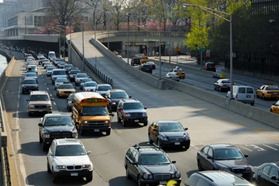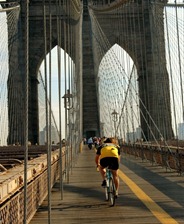Fewer Cars, More Bikes, Better Pedestrian Access in Store for U.S. Cities
 Last week, Scott Stringer, the Borough President of Manhattan in New York City, called and presided over “Transportation 2030,” a convocation of city officials, administrators, directors of NGO’s, authors and others whose focus has been moving the public around New York City — and elsewhere. The issues, like the City itself, were monumental: how to move people around the city in ways that were economic, less polluting, more convenient and improved the city’s habitability.
Last week, Scott Stringer, the Borough President of Manhattan in New York City, called and presided over “Transportation 2030,” a convocation of city officials, administrators, directors of NGO’s, authors and others whose focus has been moving the public around New York City — and elsewhere. The issues, like the City itself, were monumental: how to move people around the city in ways that were economic, less polluting, more convenient and improved the city’s habitability.
The issues are generic, and will become increasingly important to other cities across the country — and the world. With 70 per cent of humanity destined to occupy cities by 2050, moving their inhabitants and visitors in, out and around becomes not merely an issue of convenience, but one of functionality. Simply letting internal combustion vehicles continue to be a major source of transport into, out of and within cities is not a viable option. The issue of congestion has gone national: in 2010, congestion let urban American sit and crawl in traffic for an extra 4.8 billion hours, leading them to burn an extra 1.9 billion gallons of gasoline. In New York City alone, the loss to congestion was 465 million hours and $10 billion lost, not only in fuel costs and pollution, but in productive work hours to sitting in traffic.
 This time and money and human capital and well-being was lost despite the fact that New York City has one of the better and more extensive public transportation systems in the world. One of the reasons is that a surprising 46 per cent of city residents own cars. With this in mind, you would think that New York City would be discouraging car ownership, but it isn’t.
This time and money and human capital and well-being was lost despite the fact that New York City has one of the better and more extensive public transportation systems in the world. One of the reasons is that a surprising 46 per cent of city residents own cars. With this in mind, you would think that New York City would be discouraging car ownership, but it isn’t.
In fact, the city makes it easy, and in some places desirable, to own a car. Virtually all residential neighborhoods permit on-street parking, While there is less of it than on-street parkers would like, there is enough of it so that drivers who cannot afford garages are encouraged to own a car, even in areas like Manhattan, which is well-served by public transportation.
In many parts of the outer boroughs, on the other hand, public transportation can be absent or infrequent. When there is bus services connecting to the end of subway lines, the combined rides create commutes close to an hour each way. By car, the commute can be cut in half, so car ownership is encouraged.
The process has not been helped by the requirement that new buildings provide parking within the building for its occupants, artificially inflating the supply of parking, inducing more traffic and subsidizing car ownership. As a result of all these factors, car ownership in the city has increased by 120,000 vehicles over the last 10 years.
On the other hand, New York has been made much more habitable for non-drivers. The city’s subway system has been improved by newer and more frequent trains and better information about their flow, including signs that provide time-to-next-train information. The bus system, at least along major corridors, has been improved by express buses with dedicated street lanes, tagged BRT — Bus Rapid Transit lines. Along First and Second Avenue in Manhattan, the new buses have increased ridership by 30 per cent and reduced travel times by over 15%.
 Cyclists now have more than 67 0 miles of marked bike routes, although about half of these are not dedicated lanes but shared streets. The best routes have green lanes sheltered by parked cars. As a result, the number of people cycling in the city has grown steadily since 2002, doubling in the four years between 2006 and 2010.
Cyclists now have more than 67 0 miles of marked bike routes, although about half of these are not dedicated lanes but shared streets. The best routes have green lanes sheltered by parked cars. As a result, the number of people cycling in the city has grown steadily since 2002, doubling in the four years between 2006 and 2010.
However, the number of people cycling to work has hardly budged, staying below one per cent of the population. Part of that is the difficulty of parking a bike safely once you get to your office. To counter that problem, the city has contracted a bike share system that will put 10,000 bikes in 600 rental station starting in the summer of 2012.
Unlike many US cities, most of New York is a pedestrian metropolis, with most streets, even in the outer boroughs, crowded with people walking at least a part of the way to their destinations. That doesn’t mean that the city has always been friendly to its ambling inhabitants. For years, several hundred pedestrians died in traffic each year, the victims of bad traffic design, overly fast vehicular traffic and poor signage — as well as carelessness on everyone’s part.
While carelessness and bad drivers still take their toll, traffic fatalities have fallen from over 700 to less than 300 annually over the last 20 years. Better marking of crossings, pedestrian signals and better timing of lights have contributed to this decline. As most accidents occur along arterial streets such as the main avenues and major cross streets, providing pedestrian malls — such as in the Times Square, Herald Square and Madison Park areas — seems to have had good effect. Even though foot traffic increased, pedestrian injuries in these areas fell by 35 per cent.
A major effort was the city’s attempt to reduce downtown use by private cars and trucks during the day through congestion pricing, requiring a hefty daily fee to enter the restricted area in a private vehicle. This was unfortunately stricken down at the state level, although the success of this system has been demonstrated in the downtowns of major European cities, including London.
Nevertheless, it’s an idea whose time is coming. Sooner or later, it will become the norm for major cities in the U.S. As more and more people find themselves in urban settings, better air, less noise and safer streets will be demanded by all.


